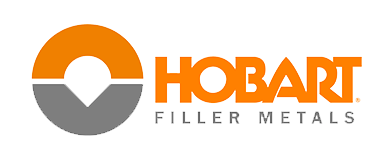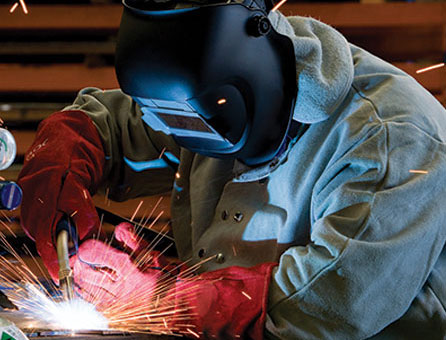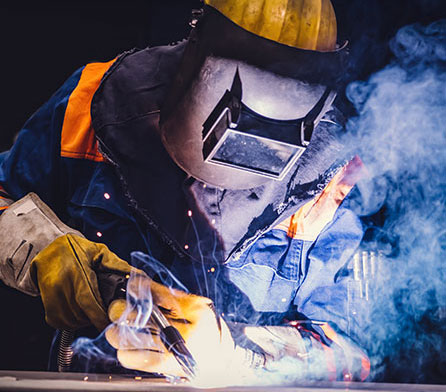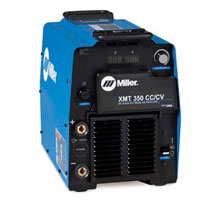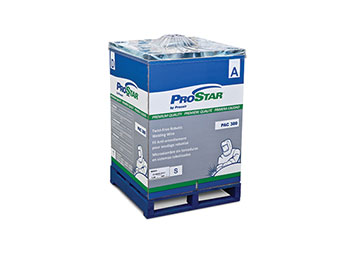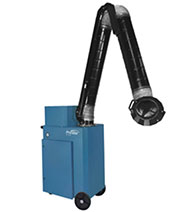What is a Welding COBOT?
What is a welding COBOT? A welding COBOT is a Collaborative Robot used in welding processes, designed to work alongside humans, with human interaction. Typical welding robots use enclosures and gates to separate the robot from workers for safety reasons. A COBOT is designed with sensors and safety features that allow them to safely work with humans without the need for safety barricades in welding environments.
Many metal fabricators can benefit from the addition of a robotic cell for welding repeatable parts. Augmenting manual processes with automation can improve throughput and product-quality, as well as lower production costs. However, the capital equipment costs, and lack of shop floor space can make this inaccessible. Additionally, operations dealing with high-mix, low volume work stream may have a hard time finding the right solution. These circumstances are where a COBOT can be a good fit.
Table of Contents:What are the Benefits of COBOT Welding? |
What Are the Benefits of COBOT Welding?
Welding COBOTs are Flexible.
COBOTs are designed to be flexible and can quickly be programmed to perform different welding tasks, making them a good choice for small-scale and specialized projects. Additionally, they can be easily reprogrammed to work on different welding projects or change configurations. This makes COBOTs useful for job shops and smaller operations where flexibility is crucial with a lower volume of throughput.
By nature, welding COBOTS are highly
adaptable and can be programmed to weld even complicated shapes and sizes. Traditional welding machines are limited in their welding capacity and cannot adapt to different requirements. Due to the flexibility of welding COBOTS, operators can easily
adjust welding parameters, making them versatile enough to work on various welding projects with ease. 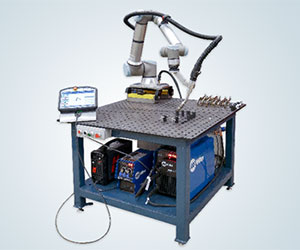
Welding COBOTs Improve Productivity.
With manual welding, human operators are subject to natural inconsistencies and fatigue. Welding COBOTs can provide consistent, higher weld travel speeds and a greater degree of accuracy. The tireless nature of automation leads to greater throughput and greater productivity, all while helping to ensure consistency from one weld to the next.
Welding COBOTs Provide Improved Consistency and Quality.
Welding COBOTs offer considerable benefits for welding by increasing consistency. They are well-programmed to carry out precise and repetitive tasks with the same consistent level of welding accuracy. Compared to manual welding methods that often produce varying results, welding COBOTS offer a high level of precision that can greatly reduce over-welding and weld quality issues.
The use of welding COBOTs in welding operations can enhance the quality of the products produced. Welding COBOTs are designed to operate efficiently, reducing the chances of human errors that are typical of traditional welding methods. As a result, manufacturing companies can produce high-quality products that are consistent in quality without worrying about rejection rates.
Welding COBOTs are Cost-Effective.
In addition to improved productivity, flexibility, and consistency, welding COBOTs are a cost-effective alternative to traditional welding robotics. Welding COBOTs offer much of the functionality of production robots at a more affordable price point. The installation of welding COBOTs in a manufacturing setup can greatly increase production rates and reduce production errors, thereby cutting down on manufacturing costs by a considerable amount, when compared to manual welding.
Welding COBOTs Are Easy to Use.
With the rise of automation in manufacturing, there has been a need to develop robotics that are user-friendly. Welding COBOTs are simpler than larger automation systems and are easier to program and operate. In addition to using provided consoles or pendants, users can physically assist programming by moving the robotic arm into place, by hand. As a result, less technical training is required and operators can quickly learn how to operate a welding COBOT.
What Industries Use Welding COBOTs?
Automotive Industry.
The use of welding COBOTs in the automotive industry is widespread. These units can provide reliable and accurate welds consistently, leading to improved production efficiency and reduced manufacturing costs. They are used in various applications such as spot welding, seam welding, and surface welding.
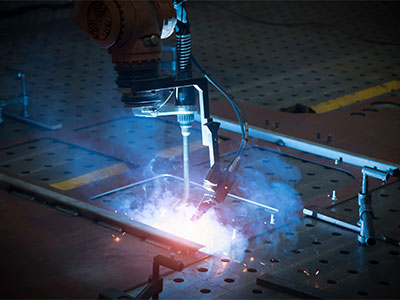
Manufacturing Industry.
The manufacturing industry requires a high level of precision in welding operations in order to maintain competitiveness. COBOTs are ideal for welding operations of intricate or complex components such as those used in manufacturing, electrical assemblies and electronics.
Aerospace Industry.
The aerospace industry requires high-quality welding operations, and welding COBOTs help ensure that the necessary quality is maintained. COBOTs are widely used in aircraft manufacturing and assemblies and help in welding frames, engines, and other components.
Transportation Industry.
The transportation industry involves the manufacturing of various components, such as rail tracks, buses, and trucks. Welding COBOTs provide a cost-effective solution for the transportation industry by allowing the welding of different components speedily and with little supervision.
In addition to these industries, welding COBOTs can be involved in other markets, such as furniture manufacturing, building structures, and shipbuilding. COBOT’s abilities to weld with great precision and consistency makes them an ideal solution for many industrial applications, reducing production costs and enhancing the quality of the products produced.
Explore Welding Automation Solutions at Linde Gas & Equipment
Welding COBOTs represent significant opportunities in the welding industry. They are user-friendly, flexible and cost-effective. The use of welding COBOTs in welding operations can help businesses improve their productivity rates, ensure consistent and high-quality welds, and reduce production costs. As a result, companies that adopt welding COBOTs are future-proofing their businesses, helping to ensure that they remain competitive into the future.
|
|
|
Linde’s PROSTAR™ LANCER™ COBOT is a great example of a high-quality, easy to use welding COBOT. It is designed for those smaller, complex tasks. Features include:
→ A 60 in. x 48 in. work area
→ 5/8 in. peg tooling compatibility
→ A 500-amp BINZEL® welding torch
→ A UR10e universal robot
→ Accommodation for MILLER® MIG welding systems
It is designed to work with your operator’s direct interaction within the work area. With available plasma cutting and fume collection options, the LANCER COBOT can help smaller operations achieve a much higher competitive position with throughput and product quality.





















